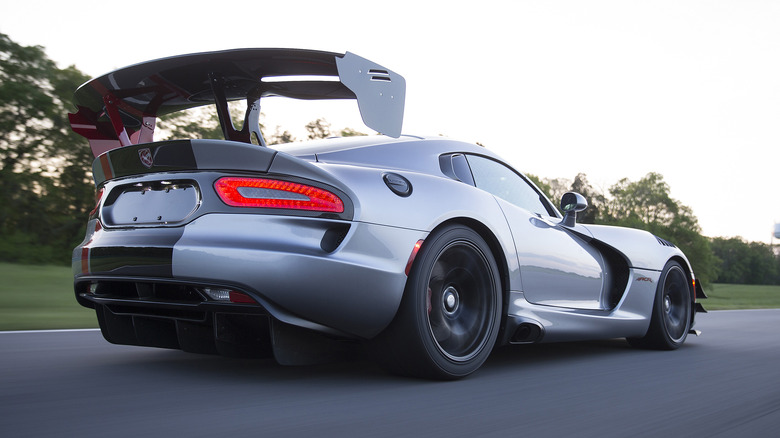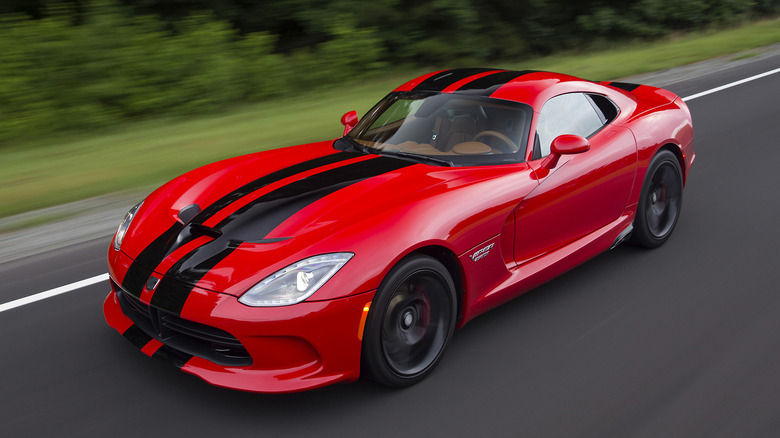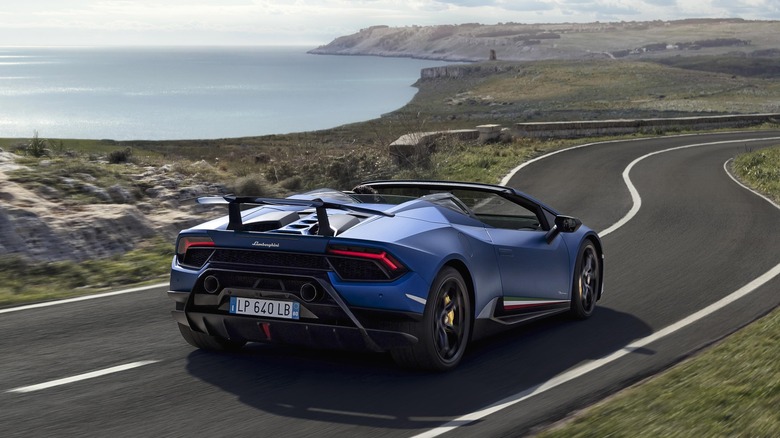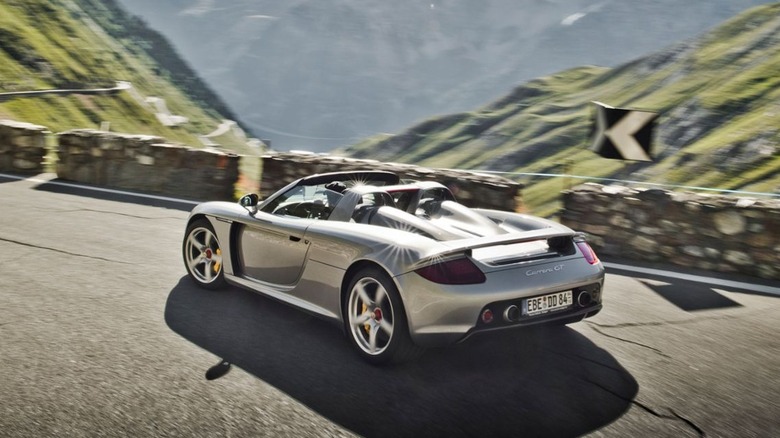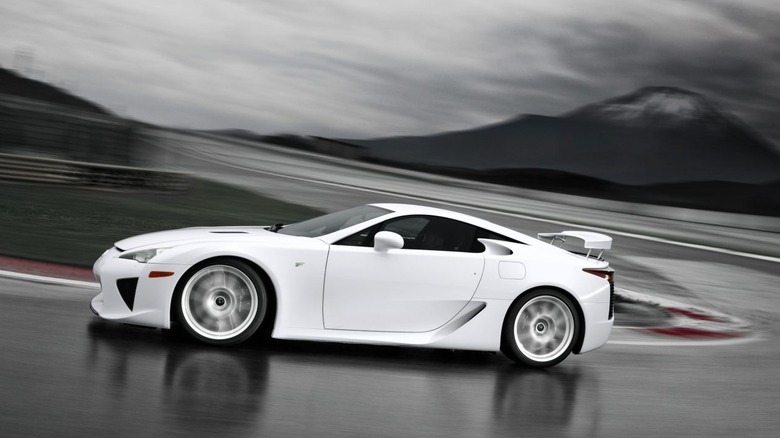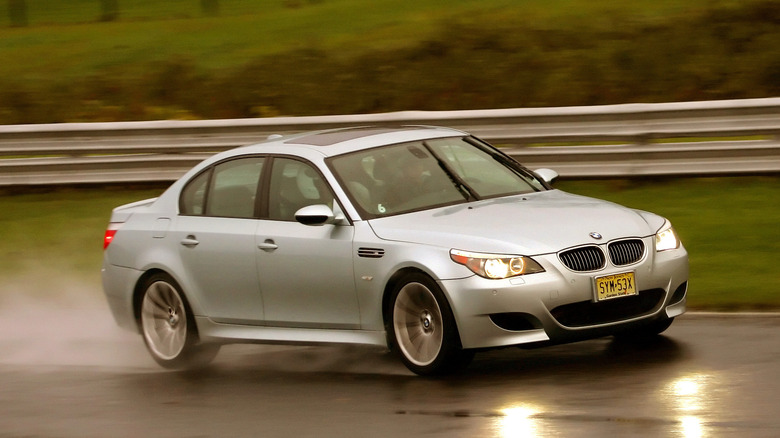5 Of The Most Powerful V10 Engines Ever Put In A Car
V10 engines aren't very common, even amongst high-performance vehicles. Cars with V8s, twin-turbo V6s, and V12s are more likely to show up on lists with "most powerful" in the title. V8 and V6 engines tend to be a bit more compact, and as a result they can be fitted with turbochargers or a supercharger for additional power. Then, for something like a flagship supercar, manufacturers are more likely to use a big V12 (or in some cases, a W16) which has more swagger.
Despite their rarity, the power and performance of V10 engines shouldn't be dismissed — they have powered some of history's most iconic cars. So let's take a look at some of the most powerful V10s ever put in a car. But first, a quick clarification: this list covers production V10 engines. Sure, there are unique coach-built cars with V10s, even some ultra-low production vehicles that might qualify, and plenty of wildly-cool V10s out there with extensive modifications and four-digit horsepower figures. But those are lists for another day — this is a list that covers production cars and their from-factory horsepower numbers.
Dodge Viper
A massive 8.4-liter engine under the hood means that the Dodge Viper has one of the largest production engines ever put in a car, with one of the highest horsepower outputs of any naturally-aspirated engine ever. Introduced in the early 1990s, the original Viper RT/10 came with an 8.0-liter V10 that produced 400 horsepower and 465 lb-ft of torque – respectable numbers for its day, and enough to make it a very fast sports car, but not a particularly high number when you consider horsepower-per-liter measurements.
The original RT/10 only made 47.6 horsepower per liter. For reference, a Honda Civic from the same era (1992) with a 1.6-liter engine made 125 hp — or 78.1 horsepower per liter. Thankfully, Dodge didn't stop making Vipers in the early '90s. They went on to make four more generations of the big two-seater, eventually increasing the V10's displacement all the way up to 8.4 liters, producing much more horsepower over the years.
By the time the Viper was taken out of production in 2017, it was making 645 horsepower and 600 lb-ft of torque – or 76.7 horsepower per liter, a much more respectable number. An honorable mention here goes to the Dodge Ram SRT 10 (a seriously strange exercise in what's possible in a pickup truck) which also used the Viper's V10, making 500 horsepower and 525 lb-ft of torque.
Lamborghini Huracán
While it doesn't sit at the top of the Lamborghini lineup (that honor belongs to the V12 models like the Revuelto and the Aventador), the Huracán is still considered one of the best Lamborghini's of all time. It has sharp styling, even-sharper handling, and a screaming V10. The Huracán uses a mid-engine layout, with the 5.2-liter V10 mounted behind the driver. It's available in rear-wheel drive and all-wheel drive configurations, as well as the rally-inspired Sterrato trim level — with lifted suspension and all-terrain tires.
The Sterrato is the least-powerful version of the Huracán currently, but it still checks in at an impressively-high 602 horsepower, while other versions of the Huracán make 631 horsepower and 417 lb-ft of torque. The Huracán's 5.2-liter V10 was also used under the hood of the Audi R8 V10 until 2023, when the R8 was taken out of production. In the R8, the 5.2-liter engine was rated as high as 602 horsepower.
This is also a good place to mention the Lamborghini Gallardo, which had an impressive V10 of its own. The Gallardo started out with a 5.0-liter V10 that produced 500 horsepower, but it eventually upgraded to a 5.2-liter engine that produced as much as 562 hp and 398 lb-ft of torque. Those are higher numbers than the M5 (listed below with its stout 500-horsepower V10) but we figured one spot for Lambos on the list was enough.
Porsche Carrera GT
While it might not be as well-known as its Porsche sibling, the 911, the Carrera GT is special in its own unique way. Built using a carbon fiber monocoque and subframe, along with several carbon fiber components and body panels, the Carrera GT is relatively lightweight considering its size and all its luxury materials. When Car and Driver tested one in 2004, it weighed in at just 3,146 pounds. That's over 250 pounds lighter than a Dodge Viper from the same era. While that's not ultra-light for a high-performance car, it is impressive considering how well appointed the GT was for its day, with a Bose stereo, unique materials like a beech wood shift knob, and soft-touch leather upholstery.
The Carrera GT had more than just a lightweight carbon fiber shell and a well-appointed interior, though — it had big power from a 5.7-liter V10 paired with a six-speed manual transmission. The 5.7-liter V10 was originally designed to be used at the 24-hours of Le Mans, but modified for use in the GT. It produced 603 horsepower and 435 lb-ft of torque. That's nearly double the horsepower (315) of a standard 911 Carrera from the same year — enough to get the Carrera GT from zero to 60 mph in just 3.5 seconds.
Lexus LFA
The Lexus LFA has the distinction of using the smallest V10 on our list. At just 4.8 liters, the LFA's displacement is smaller than many V8s in production today. And, as is typically the case, low displacement paired with a high cylinder count is a recipe for an astonishing soundtrack. The LFA is widely considered to be one of the best-sounding supercars ever built. The 4.8-liter V8 reaches peak power at 8,700 RPM, but it revs all the way to a screaming 9,000 RPM redline.
When it was released, the LFA produced 553 horsepower and 354 lb-ft of torque — impressive numbers that were enough to push it to a top speed of 202 mph. The LFA was extremely limited in its production run. Only 500 were ever produced, and from the first LFA being built until the last one rolling off the assembly line, there was a period of just 24 months. The final edition of the LFA was dubbed the Nürburgring Edition, and it produced 562 horsepower — a small increase over the original version. LFA's with the Nürburgring package were limited to just 50 of the 500 total production units.
BMW M5
The only four-door on the list, the BMW M5 is a fitting representation for high-horsepower sedans. The M5 has long been one of the best performance sedans money can buy, and back in 2010 it was at the peak of its powers. Under the hood of the M5 was a 5.0-liter V10 that produced 500 horsepower and 383 lb-ft of torque and revved to a redline of 8,250. M5 buyers had the choice of a seven-speed automatic transmission (called an SMG by BMW) or a six-speed manual.
According to BMW, the 5.0-liter V10 was inspired by Formula 1 engines that were developed between 2000 and 2005. The V10 weighed 529 pounds, the same as the V8 engine from the previous-generation M5, but with 106 added horsepower. Also known as the S85, the 5.0-liter V10 was used in the BMW M6 as well, making the same horsepower and torque numbers. Unfortunately, the V10 wouldn't last long in the M5 or the M6. It was eventually replaced by a twin-turbo V8 that made even more power.
